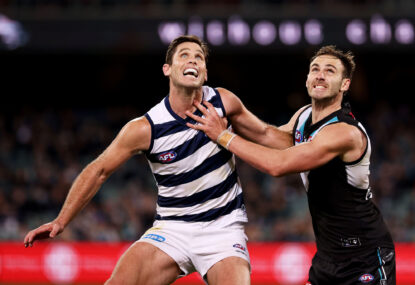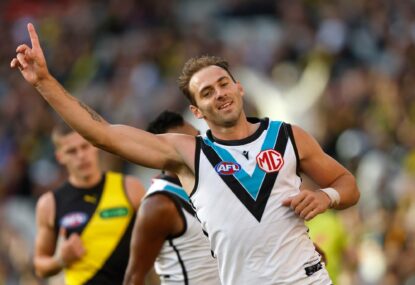Paul Puopolo’s five-goal haul not only resulted in a third straight, three-point victory for the Hawks, but it also put the need of a big full forward into perspective.
In the modern game, players are becoming more versatile, and are able to play a range of different positions.
The best full forwards in the competition aren’t the ones with the strong, bulky arms and durable hands – they are the ones who can create space, enforce pressure and kick straight.
These days, the most prolific goal kickers are small forwards.
Forward pressure has become one of the major areas of focus for most teams, as it plays an essential factor in creating turnovers and opportunities for easy goals.
To enforce efficient forward pressure, the forward line needs electrifying speed to blow the forward 50 open. The ones who do it best are the small forwards, whose ability to chase players down and create space is second to none.
Puopolo and Eddie Betts are two of the most in-form small forwards in the AFL.
They’re known to most of the competition as ‘pests’, as they’re always lingering around goals and look damaging when there’s space available, as they create vital run and opportunities to place scoreboard pressure on the opposing team.
Jake Stringer and Jeremy Cameron both boast tall statures, but lack the big bodies that define a power forward. However, this is nowhere near a bad thing, as these guys are two of the most damaging forwards in the competition.
Stringer and Cameron aren’t known for hanging around the goal square or hovering around the 50 trying to force their way past defenders. Instead, their incredible work rate enables them to work up the ground to make their opponent toil against their versatility.
They may not have a huge amount of muscle but their strength is still evident, as instead of out-competing their defender in a marking contest, they read the play and make leads into space to create opportunities for a new dimension of goal kicking.
The big talking point of the week was Travis Cloke’s demotion to the VFL.
It was a good decision by coach Nathan Buckley, as it exposed the talent of the young Collingwood forward line, who dominated on Anzac Day against the Bombers defenders.
The forward’s inaccuracy has caused Collingwood trouble for too long now, and it’s about time that Buckley conceded that he had had enough. Cloke shouldn’t slot straight back into the side this round, as Buckley needs to allow the young guys to develop if he wants to assure a more successful future for the Magpies.
The forward doesn’t have a high work rate and seems lost in the forward line. However, it’s not his fault, as the game has developed beyond the dependence of big-bodied forwards, and Cloke hasn’t adapted to the versatility of the modern forward line.
Lance Franklin is a destructive full forward but isn’t what he used to be. In fact, the Hawks are better off without him, as they’ve advanced their way into three consecutive – and successful – grand finals.
Sydney don’t value their small forwards enough, as they keep trying to combine Kurt Tippett and Franklin to set up an intimidating forward line, rather than an effective one. The two forwards may have similar statures, but their abilities differ dramatically.
Tippett is like Cloke, as he possesses a big body and is only useful for marking. His accuracy is better than Cloke’s, however his inconsistency is not good enough for the standards of the Swans, as he doesn’t kick enough goals.
Also similarly to Cloke, the Sydney forward is still not used to being ‘one of’ the targets up forward. It seems as if he prefers to be ‘the’ target up forward, which is becoming non-existent in the modern game.
Big-bodied full forwards need to become more versatile. They need to know how to play in the ruck, so that they can do more to create space for the emerging small forwards, and feed them the ball to enable a creation of sheer pace towards goal.
Forward pressure is crucial and can change the outcome of the game, as seen on the weekend.
Lachie Neale became trapped in Carlton’s forward pressure in the dying stages at Domain Stadium, as he kicked the ball straight to Liam Jones, who kicked truly and sealed the win for the Blues.
The target up forward is no longer the big full forward, it’s one of the many in the forward line.
Forward lines aren’t dependent on these big-bodied targets, instead it is quite the opposite, as small forwards are becoming more important than ever, and play an essential role in the attack of the most efficient teams in the AFL.




































































































